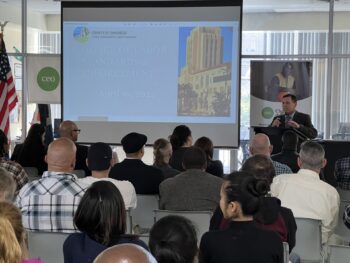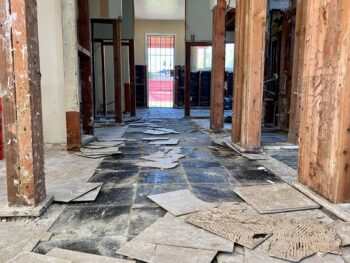Two years ago, the state shifted responsibility for tens of thousands of felons to counties in an unprecedented upheaval to the criminal justice system called “realignment.”
On Tuesday, County public safety officials told the Board of Supervisors they’ve spent the last two years setting in motion a local plan based on research-based practices and, so far, new programs and collaborations have averted disaster and even showed promising results.
Still, with risks ahead, such as a jail population that’s reached capacity, realignment is still an open question.
“Realignment is an extremely complex change of more than 500 laws,” District Attorney Bonnie Dumanis said. “The bad news is prisoner realignment continues to be a threat to public safety, but the good news is during the past two years, we have all partnered and collaborated well here in San Diego.”
Sheriff Bill Gore said San Diego County is a model around the state.
“Nobody wanted this, nobody asked for this, but then unlike a lot of counties, when it was passed, we realized this was the law, and we had to make this work.”
State lawmakers passed Assembly Bill 109, or Public Safety Realignment, with two main aims: to save the state money and to respond to a court order to reduce prison overcrowding. Under realignment, many felons now serve their sentences in local jail instead of state prison; some state prisoners are supervised by local probation departments instead of parole agents once released, and parole violators stay in local jail instead of being returned to prison.
In Tuesday’s presentation, the above video highlighted significant changes in San Diego since AB109 took effect. Efforts included a major hiring push by the Probation Department, the creation of a new unit to handle offenders released from prison, and a new “Community Transition Center,” where all offenders released from prison are initially transported for assessment, treatment and case plan development before being released into the community.
The video also highlights new jail and court programs designed to help offenders successfully re-enter society and measures the Sheriff has taken, such as supervising some low-level offenders on GPS, (Global Positioning System) to free jail space for serious offenders.
San Diego County’s local plan for implementing realignment was developed by the Community Corrections Partnership, a body that includes representatives from the District Attorney, the Sheriff’s Department, the Probation Department, the Public Defender and the Health and Human Services Agency.
Officials on Tuesday presented new programs in development to help meet the plan’s aims and protect public safety. The Board on Tuesday approved a Probation Department request to solicit proposals to provide offenders’ transitional housing services.
Chief Probation Officer and Community Corrections Partnership Chairman Mack Jenkins told the Board about 19 percent of the county’s “realigned” offenders are transient.
“Evidence-based studies suggest that housing instability increases the risk of recidivism, exposes the community to criminal behavior and reduces the likelihood of criminal offenders successfully re-entering the community,” Jenkins said.
The new program, developed by County criminal justice departments, the Health and Human Services Agency and the Housing and Community Development Department, would provide a safe and stable living environment for up to 12 months for some homeless offenders. During this period, the probation officer and service providers will work with the offender to help him or her reach goals towards self-sufficiency and lasting lawfulness.
Sheriff’s Commander Will Brown described the massive impact realignment has had on local jail population.
Since Oct. 1, 2011, when realignment took effect, jail population has increased by 27 percent, Brown said. As of early September, there were 1,824 people in local jail who wouldn’t have been there before realignment. Some violated their parole or community supervision terms. Most—1,281—are felons who would previously have been sent to state prison but who now receive a local jail sentence.
These offenders can be in custody for years, Brown said.
“Prior to (realignment) inmates stayed in jail for a year or less,” Brown said. “Today, inmates are being sentenced to county custody for a much longer period of time, In one case, we have an inmate sentenced to 18 years, 12 in custody and six on mandatory supervision in the community.”
| It’s too early to tell if realignment is having an effect on the crime rate |
| -Sheriff Bill Gore |
Brown said new alternative custody programs—including a soon-to-be finalized contract to send local inmates to state-run fire camps—are helping address jail capacity. He said the Sheriff’s Department has also been working intensely with the District Attorney and the Public Defender over the last two months to develop new processes and technologies to help ease population spikes in the jails. The Board approved the agencies’ request to return within 90 days with a proposed program design.
Brown also told the Board about new re-entry services in the jails. Brown and other speakers emphasized that criminal justice departments are working together in an unprecedented way to reduce the risk criminals will get out of jail and commit a new crime. The Probation Department completes an assessment and case plan for individual felons to help guide sentencing; the case plan guides jail programing and goals, and ultimately an updated plan helps ease the transition into the community.
The Board also approved a request to procure a system that will allow criminal justice agencies to better share and use information about offenders, their case plan, and their progress.
Deputy Chief Administrative Officer Ron Lane presented crime trends under realignment.
He said crime rose seven percent in San Diego County in 2012 after hitting a 30-year low in 2011. This trend was seen nationwide, not only in California under realignment. So far this year, violent crime is down six percent but property crime is up about four percent. In areas covered by the Sheriff’s Department, overall crime is down two percent.
“It’s too early to tell if realignment is having an effect on the crime rate,” Sheriff Gore said.
Gore said that information-led, collaborative law enforcement practices have helped deputies, police and probation officers smartly focus their efforts to protect the public.
RELATED VIDEO: Data Determining Where Deputies Focus
RELATED: Crime Mapping Tool Goes Countywide
With a wealth of information being shared between agencies, risky offenders are monitored no matter where they live, said Gore.
“It’s not to harass them or just put them back in our jails, but to let them know we’re out there, and to hopefully make them more successful so they don’t come back in our jails,” he said.




